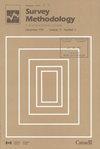评价1986年人口普查和估计加拿大人口的人口统计方法。
IF 1.2
4区 数学
Q3 SOCIAL SCIENCES, MATHEMATICAL METHODS
Survey Methodology
Pub Date : 1988-12-01
引用次数: 0
摘要
“在1986年[加拿大]人口普查中,反向记录检查和本文中提出的人口统计方法都揭示了覆盖误差的显著增加。相当重视对人口增长的各个组成部分的评价,特别是对省际移徙的评价。论文最后概述了产生普查后估计的两种替代方法:当前使用的基于普查的模型,以及结合普查使用所有相关数据的灵活模型。”本文章由计算机程序翻译,如有差异,请以英文原文为准。
A demographic approach to the evaluation of the 1986 census and the estimates of Canada's population.
"A significant increase in coverage error in the 1986 [Canadian] Census is revealed by both the Reverse Record Check and the demographic method presented in this paper. Considerable attention is paid to an evaluation of the various components of population growth, especially interprovincial migration. The paper concludes with an overview of two alternative methods for generating postcensal estimates: the currently-in-use, census-based model, and a flexible model using all relevant data in combination with the census."
求助全文
通过发布文献求助,成功后即可免费获取论文全文。
去求助
来源期刊

Survey Methodology
数学-统计学与概率论
CiteScore
0.80
自引率
22.20%
发文量
0
审稿时长
>12 weeks
期刊介绍:
The journal publishes articles dealing with various aspects of statistical development relevant to a statistical agency, such as design issues in the context of practical constraints, use of different data sources and collection techniques, total survey error, survey evaluation, research in survey methodology, time series analysis, seasonal adjustment, demographic studies, data integration, estimation and data analysis methods, and general survey systems development. The emphasis is placed on the development and evaluation of specific methodologies as applied to data collection or the data themselves.
 求助内容:
求助内容: 应助结果提醒方式:
应助结果提醒方式:


